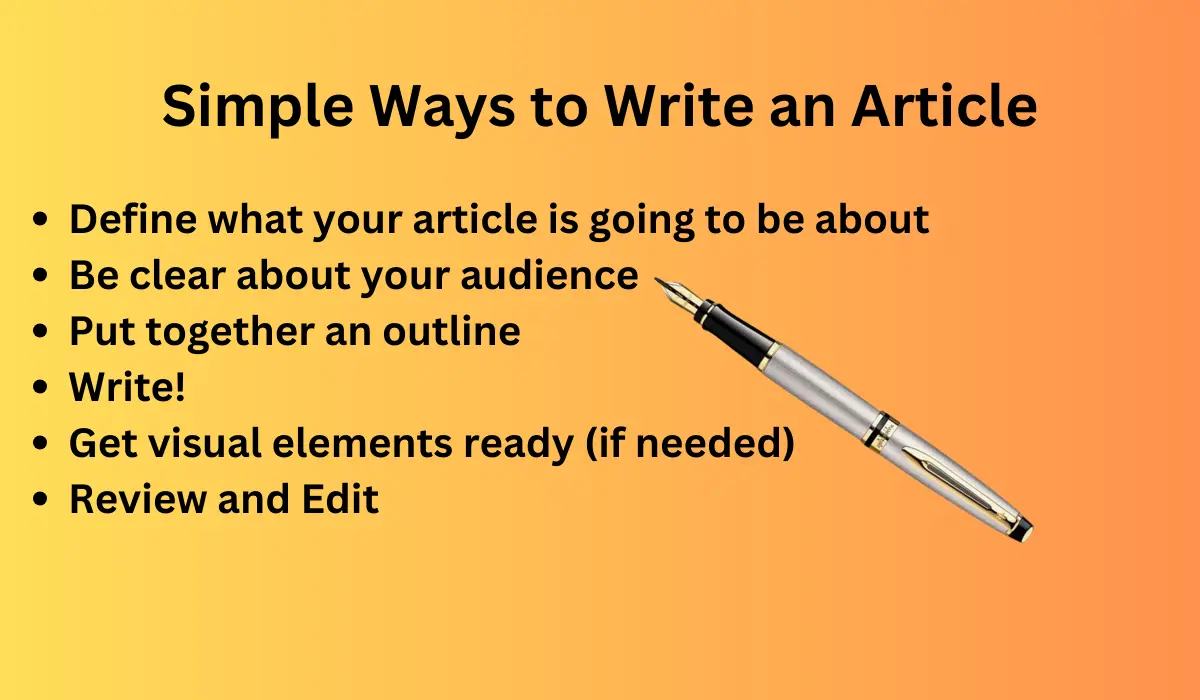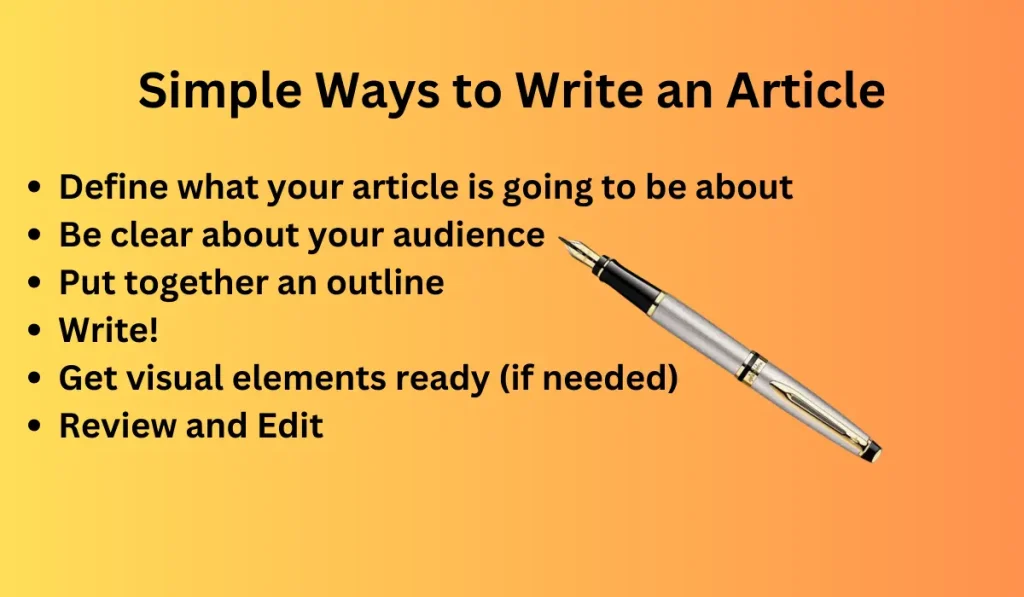If your goal is to make a living as a writer, undoubtedly, you aim to reach as wide an audience as possible. Like countless other content creators, you brainstorm topic ideas, conduct research, and dedicate hours to crafting pieces that you hope will resonate with readers. Yet, all too often, you find yourself experiencing what can only be described as the “spike of hope” – a surge in views immediately following publication, only to watch them dwindle within days. Faced with this cycle, many writers simply move on to the next piece, hoping for better luck. In this context, I share some simple ways to write an article that hits Google’s front page.
According to a study by Ahrefs, over 90% of online content fails to garner views on Google—a sobering truth that eludes many content creators.
As someone entrenched in marketing, I can attest to the challenges of creating insightful and discoverable content. It took years of experimentation with various formats and styles before I cracked the code for producing content that could secure a coveted place on the first page of Google.
But if you believe your content merits more attention, yet struggles to find its audience, consider the following statistics, which may provide some solace:
Steps Before Start Writing
Believe it or not, the initial audience for your content isn’t human—it’s search engine bots!
Think of Google’s web crawler as a diligent spider scouring the web for fresh content. Once it stumbles upon your article, it undergoes a process known as indexing, essentially “reading” and categorizing your content. Only then does your article become searchable.
If your goal is to craft content that continually attracts readers, you must also cater to search engines. How do you accomplish this? By creating content that resonates with both human readers and search engine algorithms.
Keyword Research: Unveiling the Golden Nuggets
Before diving into writing, it’s essential to conduct keyword research to optimize your chances of success. Here’s how:
Define Your Theme: Start by selecting a topic or theme for your content. Brainstorm ideas that align with your audience’s interests and your expertise.
Assess Monthly Volume and Competition: Once you’ve settled on a theme, check the monthly search volume and competition for relevant keywords. This information will help you understand the potential audience size and the level of competition you’ll face.
Utilize SEO Tools: As a marketer, I rely on Ahrefs SEO content writing tool for comprehensive research. However, you can also explore other alternatives such as:
Semrush (offers 10 free searches per month)
Moz Keyword Explorer (provides 10 free searches per month)
Ubersuggest (allows three free searches per day)
LSI Graph (completely free)
Evaluate Keyword Potential: Look for keywords with medium to low competition and a minimum of 100 global monthly searches. These keywords have the potential to rank well on Google and attract significant traffic to your content.
By conducting thorough keyword research and selecting strategic keywords, you can maximize the visibility and performance of your content in search engine results.
Quality Content: The Backbone of Success
Content is king, and Google’s algorithms prioritize quality above all else. Craft your article to be informative, engaging, and valuable to your audience. Conduct thorough research, provide unique insights, and address the needs or interests of your readers. By delivering high-quality content, you not only captivate your audience but also earn the trust of search engines.
Allow me to share another valuable tip to assist you in crafting well-optimized content.
Google’s algorithm has evolved to comprehend the underlying intent behind keywords. For instance, individuals searching for the best content marketing books may also be interested in topics like copywriting, social media, and blogging—integral components of content marketing. Hence, your article should encompass a wide range of relevant subjects to provide comprehensive coverage.
In today’s digital landscape, the effectiveness of optimized content is no longer solely determined by the frequency of your target keyword usage. Instead, it hinges on the creation of a thorough and detailed article that addresses the topic holistically.
Don’t hesitate to incorporate numerous semantically related keywords into your content if doing so enhances its utility and relevance to readers.
Embrace bold experimentation in your approach. Remember, SEO is a realm of continual experimentation, where successes and setbacks alike serve as valuable learning experiences.
Simple Ways to Write an Article
Here we are sharing some simple ways to write an article:
Define what your article is going to be about
The article will focus on providing a comprehensive guide to on-page optimization for SEO (Search Engine Optimization). It will outline the steps and best practices involved in optimizing individual web pages to improve their visibility, relevance, and ranking in search engine results. The article will cover essential aspects such as keyword research, content creation, title tags, meta descriptions, header tags, URL structure, image optimization, internal and external linking, page load speed, mobile-friendliness, and schema markup. The aim is to equip readers with actionable strategies and techniques to enhance the on-page optimization of their website content and drive organic traffic from search engines.
Be clear about your audience
The article is intended for website owners, digital marketers, content creators, and anyone interested in improving their website’s visibility and performance in search engine results. It caters to individuals seeking to enhance their understanding of on-page optimization techniques and implement actionable strategies to drive organic traffic to their websites. Whether beginners or seasoned professionals in the field of SEO, the article provides valuable insights and practical guidance for optimizing web pages effectively.
Put together an outline
An outline serves as a roadmap, keeping your writing focused and providing clarity to your readers. There’s no rigid formula for creating an outline. It can be as straightforward as a list of subtopics or subheadings, or a concise paragraph summarizing the entire article. Alternatively, employing mind maps can offer an effective outlining technique. I’ve found success with either listing subheadings or using bullet points accompanied by summaries, depending on the article’s length and complexity.
When structuring your article, dividing it into sections is advisable. Articles with explicit subheadings naturally lend themselves to this approach. Even if your piece flows freely without clear subheadings, rough sections during outlining aid organization.
At its core, your article should include an introduction and conclusion. The introduction sets the stage, ranging from a brief paragraph to several, outlining the article’s focus and key takeaways. Think of it as a marketing pitch, enticing readers to delve into the full content.
Conversely, the conclusion serves to recapitulate key points or takeaways, ideally reconnecting with the introduction. If your introduction poses a question (“How will Technology X revolutionize the retail industry?”), the conclusion should reflect on the answers provided, summarizing key discussions or reinforcing overarching ideas.
Write!
When tackling a lengthy article, it’s wise to pace yourself. Take it section by section, allowing breaks in between to rejuvenate your mind and review your progress.
Remember the fundamental principles we’ve discussed throughout this writing and reviewing process. Keep a clear understanding of your article’s focus and audience, and adhere closely to your outline.
(Quick note: If you decide to make significant changes or additions to your article while writing, it’s advisable to revisit your outline first. This ensures that you maintain an overview of how the alterations affect the overall structure of your piece).
It’s easy to get carried away in the writing flow and veer off track from your article’s core topic or intended audience. Revisiting your planning process serves as a compass to keep you on course.
Get visual elements ready (if needed)
Since visual elements can greatly enhance the readability and engagement of an article, here are some examples of visual elements that could complement the content:
Infographics: Create infographics to visually represent complex data or processes mentioned in the article. This could include charts, graphs, or diagrams illustrating key points.
Images and Illustrations: Incorporate relevant images or illustrations to break up text and make the article more visually appealing. For instance, if the article discusses different sections of an outline, include images representing each section.
Mind Maps: Visualize the outline or structure of the article using a mind map. This can help readers understand the organization of the content at a glance.
Quote Graphics: Highlight key quotes from the article in visually appealing graphics. This can draw attention to important insights and encourage social media sharing.
Screenshots or Demonstrations: If the article discusses practical steps or tutorials, include screenshots or videos demonstrating the process. This provides readers with a visual reference to complement the written instructions.
Callout Boxes: Use callout boxes to emphasize important points or tips within the article. This helps to draw attention to critical information and break up the text for easier reading.
Interactive Elements: Depending on the platform, consider incorporating interactive elements such as quizzes, polls, or interactive maps to engage readers and encourage interaction with the content.
Review and Edit
When writing a lengthy article, it’s wise to pace yourself. Take it section by section, allowing breaks in between to refresh your mind and review your progress.
Remember the fundamental principles we’ve discussed throughout this writing and reviewing process. Keep a clear understanding of your article’s focus and audience, and adhere closely to your outline.
(Quick note: If you decide to make significant changes or additions to your article while writing, it’s advisable to revisit your outline first. This ensures that you maintain an overview of how the alterations affect the overall structure of your piece).
It’s easy to get carried away in the writing flow and veer off track from your article’s core topic or intended audience. Revisiting your planning process serves as a compass to keep you on course.
As you write, strive to create seamless transitions between sections. Each section should feel like a cohesive part of the whole, rather than a disjointed collection of mini-articles. One effective technique is to begin each section by referring back to the previous one or by subtly leading into the next. Alternatively, you can start each section by reiterating the core idea or topic of the article. It’s also beneficial to periodically reinforce your core idea or topic throughout the article, ideally at least once in every section.
Also Read
Optimize On-Page SEO: The Roadmap to Visibility
On-page SEO optimization involves strategically incorporating keywords throughout your article. Ensure your target keyword is present in the title, headings, meta description, and body content. However, maintain a natural flow of language and avoid keyword stuffing, which can negatively impact your rankings. Additionally, optimize images with descriptive alt tags and prioritize fast page loading times for enhanced user experience.
Create Compelling Headlines: Captivate and Conquer
Your headline is the gateway to your article. Craft a compelling and descriptive headline that entices users to click through. Incorporate powerful words and emotional triggers to grab attention and convey the value proposition of your content. Remember, a captivating headline is the first step towards securing a coveted spot on Google’s front page.
Write Meta Descriptions: The Elevator Pitch
Meta descriptions provide a summary of your article in search results. Craft compelling meta descriptions that accurately reflect the content of your article and entice users to click through. By optimizing meta descriptions, you increase the likelihood of users choosing to engage with your content.
Header Tags (H1, H2, etc.):
Use header tags (H1, H2, etc.) to structure your content hierarchically. Include your target keyword in at least one header tag to signal its importance to search engines.
URL Structure:
Create clean and descriptive URLs that reflect the content of your page. Incorporate your target keyword into the URL if possible, but keep it concise and readable.
Optimize Image Alt Tags:
Use descriptive alt tags for images to improve accessibility and provide context to search engines. Include relevant keywords in alt tags when appropriate, but ensure they accurately describe the image.
Internal Linking:
Incorporate internal links to other relevant pages on your website. Use anchor text that includes keywords related to the linked page to improve topical relevance and crawlability.
External Linking:
Include outbound links to authoritative sources and relevant websites. Link to reputable sources that provide additional value to your readers and enhance the credibility of your content.
Optimize Page Load Speed:
Ensure fast loading times by optimizing images, minimizing server response times, and leveraging browser caching. Use tools like Google PageSpeed Insights to identify and address performance issues.
Mobile-Friendliness:
Design your website to be responsive and mobile-friendly. Test your pages using Google’s Mobile-Friendly Test to ensure they provide a seamless experience across devices.
Schema Markup:
Implement schema markup to provide search engines with additional context about your content. Use structured data markup to enhance rich snippets and improve visibility in search results.
Promote Your Content: Spread the Word
Share your article across social media platforms, forums, and relevant online communities to increase its visibility and attract traffic. Encourage engagement and backlinks to signal to search engines the relevance and authority of your content. Promoting your article effectively amplifies its reach and enhances its chances of hitting Google’s front page.
Monitor and Update: Stay Ahead of the Curve
Keep a close eye on your article’s performance using tools like Google Analytics and Search Console. Monitor keyword rankings, organic traffic, and user engagement metrics to gauge the effectiveness of your strategies. Regularly update your article to keep it relevant and aligned with evolving search engine algorithms.
Patience and Persistence: The Key to Success
Achieving a front-page ranking on Google requires patience and persistence. Continuously refine your SEO strategies, produce high-quality content, and adapt to the ever-changing landscape of search engine optimization. By staying committed to your goals and implementing best practices, you can unlock the potential of your content and secure a coveted spot on Google’s front page.
End Words
In conclusion, writing an article that hits Google’s front page is a multifaceted endeavor that requires meticulous planning, strategic execution, and ongoing optimization. By incorporating keyword research, producing quality content, optimizing for SEO, and promoting effectively, you can increase your chances of achieving top rankings on the world’s most powerful search engine. So, roll up your sleeves, unleash your creativity, and embark on the journey to front-page success.





